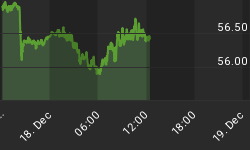Tech stocks have been laggards in recent weeks, which has been a little concerning for the current rally despite the numerous bullish signals we outlined on July 16. Earnings may provide a needed push for tech stocks. From Bloomberg:
EBay, the world's largest Internet marketplace, jumped 5.7 percent in pre-market New York trading. IBM gained 2.3 percent as the biggest computer-services provider also raised its full- year profit forecast. Qualcomm (QCOM) Inc. increased 4.9 percent after results showed consumers in emerging markets are trading up to next-generation mobile-phone handsets.
The relative weakness in tech stocks may be yesterday's news with downside momentum vs. the S&P 500 waning relative to the height in late April. A positive or bullish divergence occurs when price makes a new low and an indicator makes a higher low, which is indicative of slowing bearish momentum. A clear bullish divergence in favor of tech stocks can be seen below by comparing the slope of the red line near point A to the slope of the green line near point B. The chart shows the performance of tech stocks (QQQ) relative to the S&P 500 (SPY).

In early July, we presented the chart below as part of our rationale for re-entering the oil market. Clear bullish divergences were in place for oil on June 28, similar to the QQQ/SPY chart above. Including early trading on July 19, crude oil has been up for five straight days and is significantly above the price shown in the June 28 chart below. In the case of oil, the bullish divergences helped spot an opportunity to profit.

We remain bullish, but short-term we would like to see how the S&P 500 handles the possible overhead resistance below.

The S&P 500 has also reached the top of the alternate trend channel shown below. The current technical landscape, as measured by our market risk model, is similar to early January 2012 (near point A). The breakout near point A was followed by a strong rally. The previous breakout below point C was a bullish head fake. Given the readings on our risk model and the market's recent action near point E, we believe the odds favor a more sustained breakout in the present day, rather than a bull trap similar to the price action near point C. Notice prior the "C" breakout, price was congregating in the lower half of the blue trend channel, which is an indication of weakness (left of point D). Recent price action has taken place in the upper trend channel near point E, which is indicative of a stronger market. A successful breakout has not taken place as of Wednesday's close, which is the next logical step before we become overly concerned with the post-breakout probabilities. For now, the chart below shows overhead resistance.

On July 6, we noted the Fed has the political and economic cover to launch QE3 in the coming months. This morning's weekly jobless claims report did nothing but improve the odds for another round of quantitative easing. From the Wall Street Journal:
The number of U.S. workers filing applications for jobless benefits rose sharply last week, as seasonal factors play havoc with the data. Initial jobless claims grew by 34,000 to a seasonally adjusted 386,000 in the week ended July 14, the Labor Department said Thursday. It was the largest weekly gain since April 2011. Economists surveyed by Dow Jones Newswires had forecast 365,000 new applications for jobless benefits last week.
From an intermediate-term perspective, the bears have a difficult case to make. If economic data and earnings come in better than expected, that favors the bulls. If stocks were to pull back over the next two weeks, that would increase the odds of a favorable Fed statement, which is bullish. If the economic data comes in soft over the next two weeks, that too favors a bullish Fed statement on August 1.
We have been open to bullish outcomes for almost eight weeks, as outlined in a May 25 bullish divergences video. We will continue to stay with the current uptrends as long as they remain intact. While not the preferred scenario, we can still envision another rather significant pullback in stocks. Given what we know today and in the context of an upcoming Fed meeting, intermediate-term weakness would be viewed as an opportunity to invest cash at more favorable prices.















